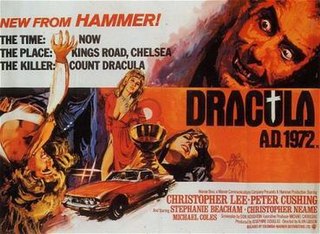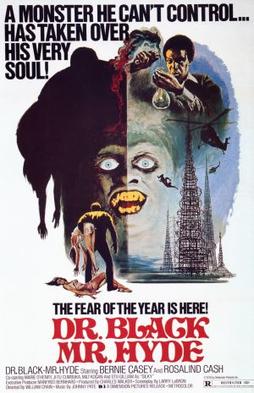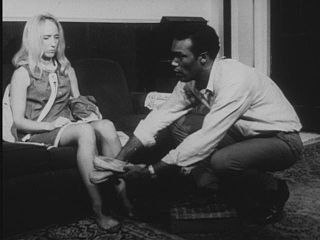History
Blaxploitation films, regardless of subgenre, spawned from race movies. These were films that started appearing in the 1930s–1940s. They were meant to segregate films featuring an all black cast from mainstream Hollywood movies. Many of these films already had the element of horror integrated into them. Over time these films transcended into their own subgenre of film, blaxploitation horror films. In the 1950s to 1960s Hollywood started to integrate films produced and starring African Americans into mainstream media.
There was backlash by several African American directors and actors that did not want to be integrated into mainstream media. They wanted to stay independent which caused them to create more of what were originally known as race movies. [1] This happened during the 1960s–70s which was during the time of the Civil Rights Movement.
African Americans were in fury at ongoing white oppression and wanted something that they could call their own. [2] They began creating films that were directed, starring, and produced by African Americans. In an effort to maintain their cultural identity they made it a point to emphasize the stereotypes the white media was portraying them as. They called this genre blaxploitation. Many blaxploitation films have a mix of comedy and horror.
However, director William Crain took the aspect of horror in these films one step further and created the first blaxploitation horror film, Blacula. As a result, a new subgenre of blaxploitation was created, dedicated solely to horror. [3]
Blacula
Blacula , filmed in 1972, was the first ever blaxploitation horror film. The film was directed by William Crain and starred William Marshall, Vonetta McGee, and Denise Nicholas. The film was a parody of the popular film Dracula. In the film Blacula, played by William Marshall, an African prince named Mamuwalde is bitten by Count Dracula (Charles Macaulay) himself and is turned into a vampire. An interracial gay couple of interior decorators buy the coffin that Blacula has been in for the last 200 years (technically, 192 years as the prologue is set in 1780) and bring him back to their home in Los Angeles. Blacula has not fed in all that time as a result of Count Dracula's effort to punish him.
Once he freed from his coffin, Blacula goes loose on the streets of Los Angeles and becomes the black avenger. He terrorizes the city in his effort to quench his thirst for blood. While on his search to kill he meets a woman named Tina (Vonetta McGee) that looks just like his departed wife. He believes that she is the reincarnation of his wife and is bent on winning her affection by any means necessary. Tina's friend Gordon Thomas (Thalmus Rasulala) finds out that Blacula is a vampire and tries to kill him. [5]
While Blacula can be viewed as a merely a cheesy parody of the film Dracula with an all black cast, it should also be noted for its portrayal of human sexuality and politics. Before becoming a vampire, Blacula was an African prince that wanted to connect Africa with the West. He tries to form this connection in an effort to stop the slave trade.
Since the first part of the film is set right before the 19th century it can be taken to mean that the slave trade they are referring to in the film was the North Atlantic slave trade. This gives insight into the way Africans viewed the slave trade. Blacula goes to Count Dracula to ask him to stop the slave trade. Unfortunately, Count Dracula likes the slave trade and wants to keep it in existence.
This can be viewed as to how Africans saw whites as oppressors that wanted to reap the benefits of the slave trade. Not only was Blacula brought to America by two interior decorators, but they were a gay interracial couple. This was very ground breaking at the time when racial prejudice and homophobia was running rampant at the time of the film's release. [6]
Despite the controversies, the film Blacula went on to be named one of Variety's Top 50 Movies of 1972 and to win Best Horror Film of 1972 by the Academy of Horror Films and Science Fiction Films. Crain went on to film the sequel Scream Blacula Scream ; although it was not as successful, it is still considered a notable horror film (see below). [7]
Social impact
Blaxploitation horror films are a way for African Americans to maintain a cultural identity that the white media have been trying to take away from them. Harry M. Benshoff, a professor of film at the University of North Texas, describes blaxploitation horror films as "address[ing] the specific fantasy needs of the black social imaginary". [11] In other words, these films are helping to portray what the African American community wants to see in their community. These films were meant to be a form of identification and empowerment to the black community and to help overcome racial bias. [11]
Blaxploitation horror films engage a number of contemporary social and political concerns. As Jamil Mustafa demonstrates, they appropriate the archetypes of Gothic fiction and film to address "issues of vital importance to American society and culture in the 1970s", including "race relations, the movements for civil and gay rights, the Vietnam War, illicit medical experimentation, and tensions between minorities and the police". [12]
Many of the monsters portrayed in these films can be seen as representations of black power and black pride. They also tend to push the boundaries of human sexuality. Much of the plot tends to be driven by sex. Blaxploitation horror films involving vampires explore queerness and the relationship between the movements for black and gay civil rights. [13] Characters that are seen as stereotypically "normal" are often rejected by the audience because they are not as easy to relate to. These characters would include the authority figure (mentioned above) and heterosexual couples. While these characters are often able to be related to in mainstream media, oppressed people tended to see them as a representation of their oppressors. [14]
Controversy
While many people viewed blaxploitation horror as a celebration of African American culture, others did not view them in such a positive light. People started to view these films as perpetuating negative stereotypes about the African American community. There were leagues formed to prevent the making of these types of films. Members of the NAACP founded The Coalition Against Blaxploitation Movies. They even went on to use radical tactics to stop the productions of certain films. William Crain stated in an interview that members of the Coalition Against Blaxploitation Movies tied him up in a chair and told him to leave his studio in an effort to stop production of one of his films. [15]
Many of the films portrayed African American males as a stereotype of hyper-sexual beasts who ravish and demoralize woman. They help to portray the fear that the white media has instilled in its viewers. These films depicting motifs of the African American male raping white women are seen as misogynist.
Many of these horror films address the stereotype of African Americans partaking in bestiality. The monsters that African Americans portray in these films tend to be more animalistic compared with monsters in mainstream Hollywood films. The animalistic monsters supposedly go around terrorizing and having sex with the female actors in an effort to portray bestiality.
As urban horror films emerged in the 1990s, they began to portray African Americans as gangsters and thugs living in the "ghetto" that partake in illegal activities and take advantage of women. [16]
1990s–2010s
Due to the controversy surrounding blaxploitation horror films, many are no longer being made. Many film production companies see the theme as a fad that has run its course and decided to stop funding the projects. While some directors have continued to produce these types of films, like Black Devil Doll from Hell and Tales from the QuadeaD Zone they were produced with a minimal budget and were poorly made. New York filmmaker Sean Weathers continues to make films in the blaxploitation horror genre.
During the early 1990s a group of African American directors sought to revive the genre. They put a modern twist on it by setting the films in urban areas, these films were directed at African Americans who lived in "the hood." They portrayed themes of crime, drugs, and poverty in an effort to relate to the new generation of oppressed African Americans. [17]
For example, the 1990 black urban horror film Def by Temptation , directed by James Bond III, looks at a group of urban, African American professionals during the AIDS epidemic. Bond wanted to show the ever-present danger of AIDS in the urban community at the time. [18]
Also, many of the films have influences of hip hop in them, and even star rappers like LL Cool J and Snoop Dogg (mentioned above), as well as others like Ice Cube, Ice-T, Will Smith, Busta Rhymes, Redman, Method Man, Treach, Rah Digga, Mos Def, Tone Loc, MC Eiht, Spice 1, Mack 10, Ja Rule, Sticky Fingaz, Fredro Starr, Big Gipp, Kurupt, Mia X, Master P, and Lil' Romeo. [19]
The 2001 urban horror film Bones, directed by Ernest R. Dickerson and starring the rapper Snoop Dogg, is an example of the hip hop influences that have been introduced to this genre. The film is about a gangster that comes back from the dead to avenge his murder. [20]

An exploitation film is a film that tries to succeed financially by exploiting current trends, niche genres, or lurid content. Exploitation films are generally low-quality "B movies", though some set trends, attract critical attention, become historically important, and even gain a cult following.

I'm Gonna Git You Sucka is a 1988 American blaxploitation parody film written, directed by and starring Keenen Ivory Wayans in his directorial debut. Featured in the film are several noteworthy African-American actors who were part of the genre of blaxploitation: Jim Brown, Bernie Casey, Antonio Fargas and Isaac Hayes. It co-stars John Vernon, Kadeem Hardison, Ja'net Dubois, John Witherspoon, Damon Wayans, Clarence Williams III and Chris Rock, and acts as the film debuts of comedian Robin Harris and brothers Shawn and Marlon Wayans.

Vampire films have been a staple in world cinema since the era of silent films, so much so that the depiction of vampires in popular culture is strongly based upon their depiction in films throughout the years. The most popular cinematic adaptation of vampire fiction has been from Bram Stoker's 1897 novel Dracula, with over 170 versions to date. Running a distant second are adaptations of the 1872 novel Carmilla by Sheridan Le Fanu. By 2005, the Dracula character had been the subject of more films than any other fictional character except Sherlock Holmes.

Blacula is a 1972 American blaxploitation vampire horror film directed by William Crain. It stars William Marshall in the title role about an 18th-century African prince named Mamuwalde, who is turned into a vampire by Count Dracula in the Count's castle in Transylvania in the year 1780 after Dracula refuses to help Mamuwalde suppress the slave trade.

Dracula A.D. 1972 is a 1972 British horror film, directed by Alan Gibson and produced by Hammer Film Productions. It was written by Don Houghton and stars Christopher Lee, Peter Cushing and Stephanie Beacham. Unlike earlier films in Hammer's Dracula series, Dracula A.D. 1972 had a contemporary setting in an attempt to update the Dracula story for modern audiences. Dracula is brought back to life in modern London and preys on a group of young partygoers that includes the descendant of his nemesis, Van Helsing.

D'Urville Martin was an American actor in both film and television. He appeared in numerous 1970s movies in the blaxploitation genre. He also appeared in two unaired pilots of what would become All in the Family as Lionel Jefferson. Born in New York City, Martin began his career in the mid-1960s and soon appeared in prominent films such as Black Like Me, Guess Who's Coming to Dinner, and Rosemary's Baby. Martin also directed films in his career, including Dolemite, starring Rudy Ray Moore.

Scream Blacula Scream is a 1973 American blaxploitation vampire horror film. It is a sequel to the 1972 film Blacula. The film was produced by American International Pictures (AIP) and Power Productions. This was the acting debut of Richard Lawson.

Blackenstein is a 1973 American blaxploitation horror film directed by William A. Levey, and starring John Hart, Ivory Stone, Andrea King, Roosevelt Jackson, Joe De Sue, Nick Bolin and Liz Renay. It is loosely based on Mary Shelley's 1818 novel Frankenstein; or, The Modern Prometheus. Released on August 3, 1973, it was made in an attempt to cash in on the success of Blacula; released the previous year by American International Pictures. However, Blackenstein fared poorly in comparison to its predecessor, with most reviews agreeing that the film was "a totally inept mixture of the worst horror and blaxploitation films".

Dr. Black, Mr. Hyde is a 1976 blaxploitation horror film loosely inspired by the 1886 novella Strange Case of Dr. Jekyll and Mr. Hyde by Robert Louis Stevenson. The film stars Bernie Casey and Rosalind Cash, and was directed by William Crain. Along with Crain, and it was written by Larry LeBron and Lawrence Woolner with cinematography by Tak Fujimoto. It was filmed primarily in Los Angeles, at locations such as the Watts Towers.

Sugar Hill is a 1974 American horror blaxploitation zombie film, directed by Paul Maslansky and starring Marki Bey as the title character who uses voodoo to get revenge on the people responsible for her boyfriend's death. It was released by American International Pictures. According to the film, the zombies are the preserved bodies of slaves brought to the United States from Guinea. AIP had previously combined the horror and blaxploitation genres with Blacula (1972) and its sequel Scream Blacula Scream (1973).
William Crain is an American film and television director. He was one of the first black filmmakers from a major film school to achieve commercial success.

Blaxploitation is an ethnic subgenre of the exploitation film that emerged in the United States during the early 1970s, when the combined momentum of the civil rights movement, the black power movement, and the Black Panthers spurred African-American artists to reclaim the power of depiction of their ethnicity, and institutions like UCLA to provide financial assistance for African-American students to study filmmaking. This combined with Hollywood adopting a less restrictive rating system in 1968. The term, a portmanteau of the words "black" and "exploitation", was coined in August 1972 by Junius Griffin, the president of the Beverly Hills–Hollywood NAACP branch. He claimed the genre was "proliferating offenses" to the black community in its perpetuation of stereotypes often involved in crime. After the race films of the 1940s and 1960s, the genre emerged as one of the first in which black characters and communities were protagonists, rather than sidekicks, supportive characters, or victims of brutality. The genre's inception coincides with the rethinking of race relations in the 1970s.
Imaging Blackness is the complex concept of expressing, recognizing, or assigning specific sets of ideas or values used in the depiction of Black people. This depiction can be shown through various forms of media: film, television, literature. More specifically in film, the portrayal of Black people as been imaged and captured throughout history.

Depictions of race in horror films have been the subject of commentary by fans and academics. Critics have discussed the representation of race in horror films in relation to the presence of racist ideas, stereotypes and tropes within them. The horror genre has conversely also been used to explore social issues including race, particularly following popularization of social thrillers in the 2010s.

African American cinema is loosely classified as films made by, for, or about Black Americans. Historically, African American films have been made with African-American casts and marketed to African-American audiences. The production team and director were sometimes also African American. More recently, Black films featuring multicultural casts aimed at multicultural audiences have also included American Blackness as an essential aspect of the storyline.

Horror Noire: A History of Black Horror is a 2019 American documentary film directed by Xavier Burgin and based on the 2011 non-fiction book Horror Noire: Blacks in American Horror Films from the 1890s to Present by Robin R. Means Coleman. The film examines the evolution of the genre of black horror. It features interviews with Coleman, along with such figures as actors Keith David, Tony Todd, and Rachel True, director Jordan Peele, and author Tananarive Due.

The history of horror films was described by author Siegbert Solomon Prawer as difficult to read as a linear historical path, with the genre changing throughout the decades, based on the state of cinema, audience tastes and contemporary world events.
Black horror is a horror subgenre that focuses on African-American characters and narratives. It is largely a film genre. Black horror typically, but not always, has Black creators. It often has social and political commentary and compares racism and other lived experiences of Black Americans to common horror themes and tropes. Early entries in the genre include the 1940 Spencer Williams Jr. film Son of Ingagi and the 1968 George Romero horror film Night of the Living Dead, which is considered one of the first Black horror films for having the Black actor Duane Jones in its lead role. Blaxploitation horror films of the 1970s, namely Blacula (1972), and the vampire film Ganja & Hess (1973) became prominent examples of Black horror films in the 1970s. Other Black horror films appeared during the 1990s, notably the 1992 Bernard Rose film Candyman and the 1995 anthology film Tales from the Hood, which was directed by Rusty Cundieff and has been described as the "godfather of Black horror".














